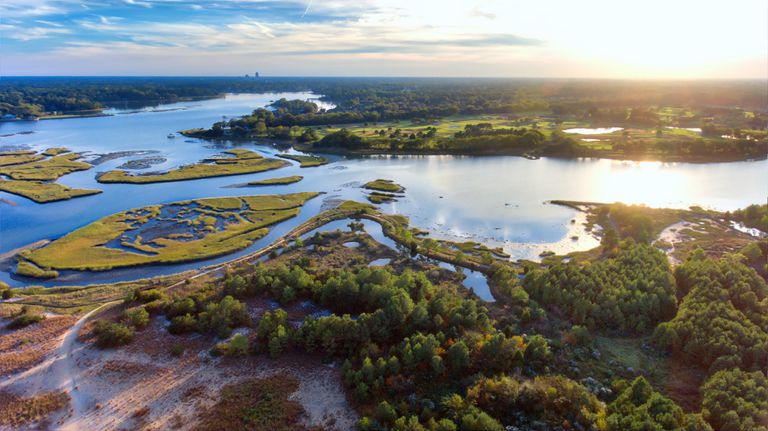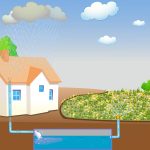Meaning of Watershed Management:
The word “watershed” introduced in 1920 was used for the “water parting boundaries”. Watershed is that land area which drains or contributes runoff to a common outlet. Watershed is defined as a geo-hydrological unit draining to a common point by a system of drains. All lands on earth are part of one watershed or other. Watershed is thus the land and water area, which contributes runoff to a common point.
A watershed is an area of land and water bounded by a drainage divide within which the surface runoff collects and flows out of the watershed through a single outlet into a lager river or lake. Watershed technology is used in Rainfed areas.

Watershed management implies an effective conservation of soil and water resources for sustainable production with minimum non point resources (NFS) pollutant losses. It involves management of land surface and vegetation so as to conserve the soil and water for immediate and long term benefits to the farmers, community and society as a whole.
Catchment area is the water collecting area. “All the areas from which water flows out into a river or water pool”.
Types of Watershed Management:
Watershed is classified depending upon the size, drainage, shape and land use pattern.
a. Macro watershed: 1000 -10,000 ha
b. Micro watershed: 100 -1000 ha
c. Mini watershed: 10 -100 ha
d. Mille watershed: 1 -10 ha
Objectives of Watershed Management:
a. Production of food, fodder, fuel.
b. Pollution control
c. Over exploitation of resources should be minimized
d. Water storage, flood control, checking sedimentation.
e. Wild life preservation
f. Erosion control and prevention of soil, degradation and conservation of soil and water.
g. Employment generation through industrial development dairy fishery production.
h. Recharging of ground water to provide regular water supply for consumption and industry as well as irrigation.
i. Recreational facility.
Main Components of Watershed:
a. Soil and water conservation,
b. Water harvesting and water management,
c. Alternate land use system.
Irrigation Projects:
Major – Covered > 10,000 ha of catchments command area (CCA)
Medium-2,000 to 10,000 ha of CCA
Minor-<2,000 ha of CCA
Steps in Watershed Management:
Watershed management involves determination of alternative land treatment measures for, which information about problems of land, soil, water and vegetation in the watershed is essential. In order to have a practical solution to above problem it is necessary to go through four phases for a full scale watershed management.
Programme:
a. Recognition phase.
b. Restoration phase.
c. Protection phase.
d. Improvement phase.
(i) Recognition Phase:
It involves following steps
(a) Recognition of the problem
(b) Analysis of the cause of the problem and its effect.
(C) Development of alternative solutions of problem.
(ii) Restoration Phase:
It includes two main steps.
(a) Selection of best solution to problems identified
(b) Application of the solution to the problems of the land
(iii) Protection Phase:
This phase takes care of the general health of the watershed and ensures normal functioning. The protection is against all factors which may cause determined in watershed condition.
(iv) Improvement Phase:
This phase deals with overall improvement in the watershed and all land is covered. Attention is paid to agriculture and forest management and production, forage production and pasture management, socio economic conditions to achieve the objectives of watershed management.
Water Resources Development Plan:
Water resource management plays a vital role in sustainable development of watershed which is possible only through the implementation of various water harvesting technique. The efficient way for sub-surface water storage, soil moisture conservation or ground water recharge technologies should be adopted properly under water resource development plan.
The various measures adopted under soil and water harvesting is:
(a) Vegetative barriers
(b) Building of contour bunds along contours for erosion
(c) Furrow/Ridges and Furrow ridge method of cultivation across the slope.
(d) Irrigation water management through drip and sprinkler methods.
(e) Planting of horticultural contour species on bunds.
Watershed Management Programmes:
(i) Drought Prone Area Programme (DPAP):
Year of start: 1970-71
Objectives: Area development programme through restoration of ecological balance and optimum utilization of land, water, livestock and human resources to mitigate the effect of drought.
(ii) Desert Development Programme (DDP):
Year of start: 1977-78
Objectives: Mitigate the effect of drought in the desert area and restore ecological balance.
(iii) National Watershed Development Programme for Rainfed Agriculture (NWDPRA):
Year of start: 1986-87
Objectives: To conserve and utilize rain water from both arable and non arable lands on watershed basis. To increase the productivity of crops and to increase the fuel, fodder and fruit resources through appropriate alternate land use system.
(iv) Control of Shifting Cultivation:
Year of start: 1986-87
Objectives: Restoring ecological balance in hilly areas and improving socioeconomic conditions.
(v) World Bank Assisted Integrated Watershed Development Project:
Year of start: 1990
Objectives: To arrest the problems of environmental degradation and promote sustainable increase in agriculture production and to enhance vegetative technology of soil and water conservation for rain water conservation and for increasing crop, forage, fuel wood and timber yield of the area.
Watershed Management Practices:
A. In Terms of Purpose
(i) To increase infiltration
(ii) To increase water holding capacity
(iii) To prevent soil erosion
B. Method and Accomplishment:
(i) Vegetative measures/Agronomical measures:
(a) Strip cropping
(b) Pasture cropping
(c) Grass land farming
(d) Woodlands
(ii) Engineering measures/Structural practices:
(a) Contour bunding
(b) Terracing
(c) Construction of earthen embankment
(d) Construction of check dams
(e) Construction of farm ponds
(f) Construction of diversion
(g) Gully controlling structure
(h) Rock dam
(i) Establishment of permanent grass and vegetation
(j) Providing vegetative and stone barriers
Rainwater Harvesting:
Rainwater harvesting means collection and storage of rainwater by some mechanism to make water available for future use. An appreciable amount of precipitation, which is generally lost as surface flow, can be harvested and stored for useful purposes like drinking and providing supplemental irrigation to the crops.



Comments are closed